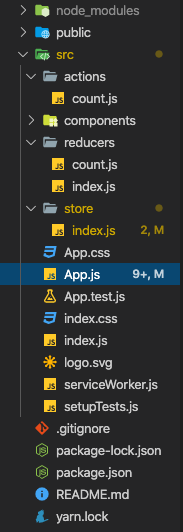Redux 적용하기 (함수형, Class 형)
React-redux

React에서 가장 많이 사용 되는 Redux 에 대하여 조금은 바닥 부터 정리를 해봤습니다.
물론 저의 글이 읽기가 진 않아서 개념 정리 보다는 코드로 풀어보도록 하겠습니다.
먼저 개념 정리는 Velopert 님 께서 아주 잘 정리해주셔서 이를 참고 하도록 하겠습니다.
Redux 란...?
요약하자면 React에서 상태를 관리하기 용이하도록 구현해낸 방법? 패턴? 이고
Action 을 정의하고 Action creator를 dispatch 하여 Reducer가 그에 맞게 Store를 변경 시켜준다고 생각하면 될것 같습니다.
그 외의 컴포넌트들은 Store를 바라보면서 변경된 Store가 있을시 그에 맞게 컴포넌트를 변경해주게 되는 겁니다.
그럼 간단한게 리액트 프로젝트에 적용해보겠습니다.
만들 프로젝트는 간단한 Count 입니다.
먼저 의존 모듈을 설치해줍니다.
$ npm i redux react-redux
actions 정의
src/actions/count.js 를 만듭니다.
// Action types
export const INCREASE_COUNT = 'count/INCREASE_COUNT';
export const DECREASE_COUNT = 'count/DECREASE_COUNT';
export const SET_COUNT = 'count/SET_COUNT';
// Action creators
export const increaseCount = () => {
return {
type: INCREASE_COUNT,
}
};
export const decreaseCount = () => {
return {
type: DECREASE_COUNT,
}
};
export const setCount = () => {
return {
type: SET_COUNT,
}
};Action types 들을 정의하고, 그에 맞는 Action creators 를 만듭니다.
reducers 정의
reducers/index.js
import { combineReducers } from 'redux';
import count from './count';
const rootReducer = combineReducers({
count,
});
export default rootReducer;index.js 를 통하여 여러 reducer를 combineReducers를 통하여 묶어 줄 수 있습니다.
실직적으로 count store를 변경시켜줄 reducer는 reducers/count.js 에 정의되어 있습니다.
reducers/count.js
import * as countActions from '../actions/count';
const initialStates = {
count: 0,
}
const reducers = (state = initialStates, action) => {
const { type } = action;
switch (type) {
case countActions.INCREASE_COUNT: {
return {
...state,
count: state.count +1
}
}
case countActions.DECREASE_COUNT: {
return {
...state,
count: state.count - 1,
}
}
default: {
return state;
}
}
}
export default reducers;
dispatch된 action type 에 의하여 reducer 는 store를 변경시켜 줍니다.
action type 이 INCREASE_COUNT 이면 state count 값을 1 증가시켜주고 DECREASE_COUNT 이면 1 감소시켜 줍니다.
이제 이렇게 만든 reducer를 전체 프로젝트 store에 올려야하는데요. 이는 매우 간단합니다. 이미 'react-redux' 에서 제공해주고 있기 때문이죠.
Store 정의
store/index.js 를 만들어서 createStore를 할 수 있게 해줍니다.
import { createStore } from 'redux';
const create = (reducers) => {
return createStore(reducers);
}
export default create;
Store 적용
마지막으로 App.js 에서
import React from 'react';
import { Provider } from 'react-redux';
import './App.css';
// Redux & Redux-Thunk test
import CountComponent from './components/Count';
import CountFCComponent from './components/CountFC';
import createStore from './store';
import reducers from './reducers';
const store = createStore(reducers); // reducers 를 바탕으로 store 생성
// Provider tag 를 통하여 전체 프로젝트에 store 적용
function App() {
return (
<Provider store={store}>
<div className="App">
<CountComponent />
<CountFCComponent />
</div>
</Provider>
);
}
export default App;
이렇게 하면 전반적인 redux 적용은 끝이납니다.
action을 생성하는 방법은 여러가지 있지만 이번 포스팅에서는 조금 더 상세하게 기능을 나누어서 기초적으로 정의해보았습니다.
보통 저는 actions 와 reducers 를 합치는 duck pattern을 주로 많이 쓰는데 추후에 포스팅해보도록 하겠습니다.
폴더 구조

컴포넌트에 Redux 적용하여 테스트
이제 실질적으로 구조가 잡힌 Redux를 실제 컴포넌트에 적용해보아야합니다.
두 가지 방법이 있는데 하나는 Class형에 적용하는법과 또 하나는 함수형에서 Hooks 를 사용하여 적용하는 법을 해보겠습니다.
Class형
./components/Count.jsx
import React from 'react';
import { connect } from 'react-redux';
import * as actions from '../../actions/count';
class Count extends React.Component {
constructor(props) {
super(props);
this.state = {
localCount: 0,
}
}
componentDidMount() {
console.log('Component did mount.');
}
increaseCount = () => {
this.setState((prevState) => {
return {
localCount: prevState.localCount + 1,
}
});
};
decreaseCount = () => {
this.setState((prevState) => {
return {
localCount: prevState.localCount - 1,
}
});
};
render () {
const { localCount } = this.state;
const { storeCount, increaseStoreCount, decreaseStoreCount } = this.props;
return (
<>
{'Class component'}
<div>
<div>
{`localCount: ${localCount}`}
</div>
<div>
{`storeCount: ${storeCount}`}
</div>
</div>
<div onClick={() => {
this.increaseCount();
increaseStoreCount();
}}>
{'+'}
</div>
<div onClick={() => {
this.decreaseCount();
decreaseStoreCount();
}}>
{'-'}
</div>
</>
)
}
}
const mapStateToProps = (state) => ({
storeCount: state.count.count,
});
const mapDispatchToProps = (dispatch) => ({
increaseStoreCount: () => dispatch(actions.increaseCount()),
decreaseStoreCount: () => dispatch(actions.decreaseCount()),
});
export default connect(mapStateToProps, mapDispatchToProps)(Count);mapStateToProps, mapDispatchToProps 을 이용하여 state, dispatch 된 action creators을 컴포넌트에 props로 전달하여 사용하는 방법입니다.
react-redux 에서 제공해주는 connect 라는 함수를 이용하여 컴포넌트와 연결 시킬 수 있습니다.
컴포넌트 내부에서는 storeCount, increaseStoreCount, decreaseStoreCount를 props로 받아서 사용하게 됩니다.
함수형
./components/CountFC.jsx
import React, { useEffect, useState, useCallback } from 'react';
import { useSelector, useDispatch } from 'react-redux';
import * as actions from '../../actions/count';
const CountFC = () => {
const dispatch = useDispatch();
const [localCount, setLocalCount] = useState(0);
const { count: storeCount } = useSelector((state) => state.count);
useEffect(() => {
console.log('Component did mount.');
}, []);
const increaseCount = useCallback(() => {
setLocalCount(localCount + 1);
dispatch(actions.increaseCount());
}, [localCount, dispatch]);
const decreaseCount = useCallback(() => {
setLocalCount(localCount - 1);
dispatch(actions.decreaseCount());
}, [localCount, dispatch]);
return (
<>
{'Function component'}
<div>
<div>
{`localCount: ${localCount}`}
</div>
<div>
{`storeCount: ${storeCount}`}
</div>
</div>
<div onClick={increaseCount}>
{'+'}
</div>
<div onClick={decreaseCount}>
{'-'}
</div>
</>
)
};
export default CountFC;보시는 바와 같이 훨씬 간단합니다. useSelector를 통하여 store에 접근하여 변수를 가져올 수 있고 useDispatch를 통하여 직접 action creator들을 dispatch 시킬 수 있습니다.
실제로 코드를 실행해보면 Function component에서 increaseCount를 하게 되면 Class component에 storeCount도 변경되는 것을 확인 해 볼 수 있습니다. Redux 를 통해서 연결되어 있기 때문에 같은 Store를 바라봐서 count가 변경되는 것이죠.
다음 포스팅에서는 비동기 처리를 위해 많이 사용되는 redux-thunk, redux-saga 를 적용시켜서 포스팅 해보겠습니다.
